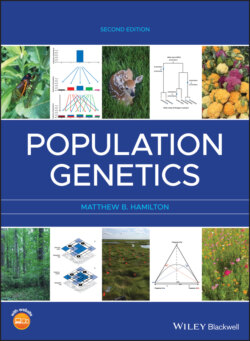Читать книгу Population Genetics - Matthew B. Hamilton - Страница 45
Natural selection
ОглавлениеNatural selection is a process that can continuously counteract the randomizing effects of recombination. Imagine a case where two locus genotypes confer different rates of survival or different levels of reproduction. In such a case, natural selection will reduce the frequency of lower fitness genotypes, which will also reduce the number of gametes these genotypes contribute to forming the next generation. At the same time that natural selection is acting, recombination is also working to randomize the associations of alleles at the two loci. Figure 2.21 shows an example of epistatic natural selection acting to maintain gametic disequilibrium in opposition to recombination acting to establish gametic equilibrium. Natural selection at one locus can also impact the frequency of nearby loci that experience limited recombination. Both hitchhiking, where natural selection rapidly increasing the frequency of a beneficial genotype alters the frequency of linked loci, and background selection, where natural selection eliminates low fitness genotypes, can lead to linkage disequilibrium at loci adjacent to the loci experiencing selection. This is because natural selection has the potential to change the frequency of haplotypes more quickly than recombination can act to randomize the arrangement of alleles found together in the same haplotype. More on these natural selection topics can be found in later chapters.
Figure 2.21 The decay of gametic disequilibrium (D) over time when both strong natural selection and recombination are acting. Initially, there are only coupling (P11 = P22 = ½) and no repulsion gametes (P12 = P21 = 0). The relative fitness values of the AAbb and aaBB genotypes are one, while all other genotypes have a fitness of 0.5, a form of epistasis for relative fitness. Unlike in Figure 2.19, gametic disequilibrium does not decay to zero over time due to natural selection that is stronger than recombination.
The action of natural selection acting on differences in gamete fitness can produce steady‐states other than D = 0 even with free recombination. In such cases, the population reaches a balance where the action of natural selection to increase the absolute value of D and the action of recombination to bring D back to zero cancel each other out. The point where the two processes are exactly equal in magnitude but opposite in their effects is where gametic disequilibrium will be maintained in a population. It is important to recognize that the amount of steady‐state gametic disequilibrium depends on which genotypes have high fitness values, so natural selection and recombination could also act in concert to accelerate the decay of gametic disequilibrium more rapidly than just recombination alone.
